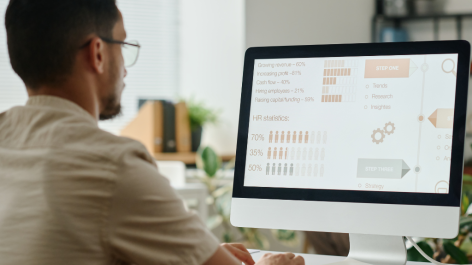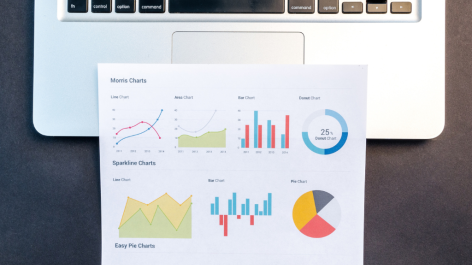Resource management has changed a lot from the days of basic tools and spreadsheets. People-based businesses face hybrid teams spread across time zones, changing project requirements, and the constant pressure to maximise efficiency while preventing burnout.
But here's the good news: the right resource management system can turn these challenges into opportunities.
In this post, we’ll look at what resource management software is and what its benefits are. We’ll also dive into how you can improve your approach and why using a resource management system like Retain can lead you to success.
If you've ever googled "resource management software" and felt overwhelmed by the jargon and competing definitions, you're not alone. So let’s define it first.
What is resource management software?
At its core, resource management software is a system that helps you manage three crucial things: your people, their time, and their skills. Think of it as your central command centre for answering essential questions like:
- Who's available to work on this new project?
- Do we have the right skills in-house for this client requirement?
- Are any teams overworked or underutilised?
- Can we take on that big project next quarter?
Essentially, the idea is to maximise productivity, reduce overspending and inefficiency, and to ensure that projects are completed on time.
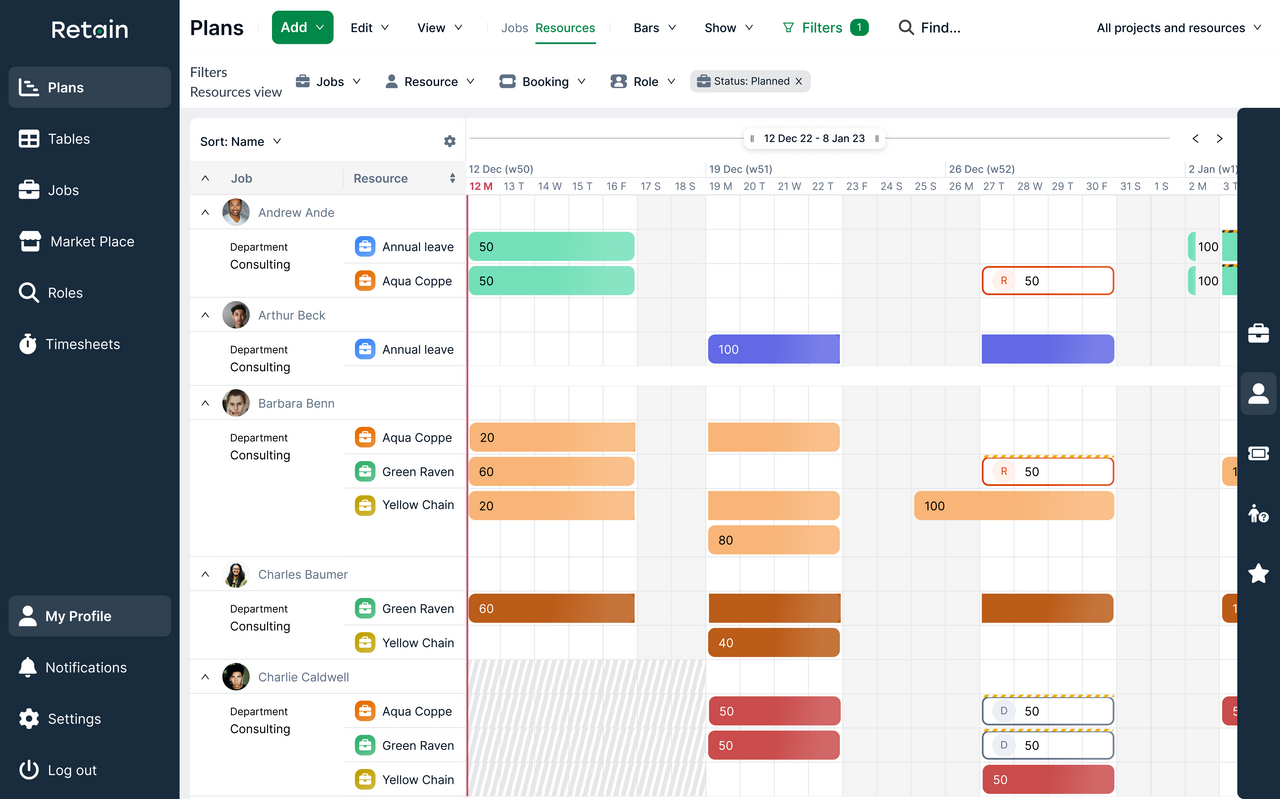
[Retain is an excellent example of resource management software]
How does a resource management system work?
Ever wondered what happens behind the scenes when you're matching people to projects? Let's break down how resource management software actually works (without the jargon).
Real-time data processing
In essence, resource management software constantly keeps track of who's doing what, who's available, and who's about to go on holiday. When you need to find someone for a project, you're not working with outdated spreadsheets—you're seeing what's happening right now.
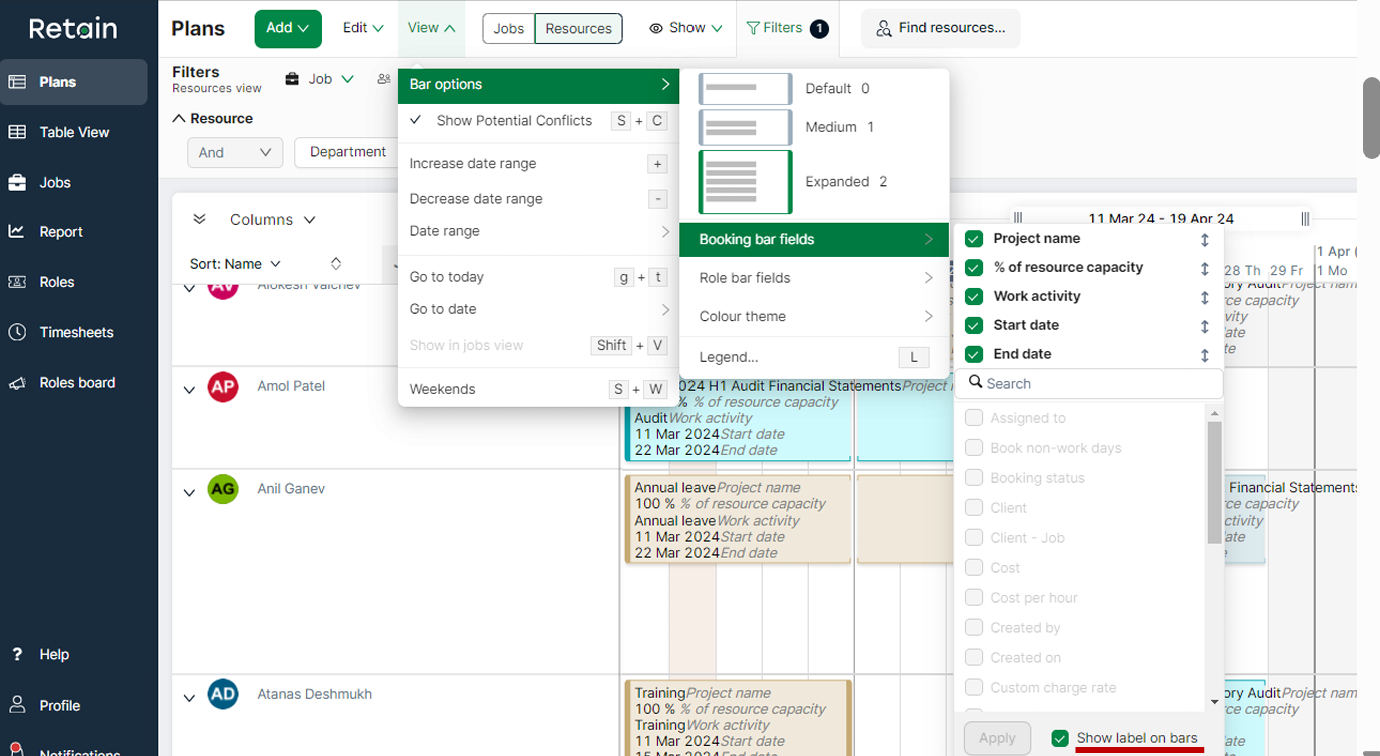
Intelligent skills matching
Here's where things get clever. Say you need a senior auditor for a three-month project starting next quarter. Instead of spending hours scrolling through team calendars and skills matrices, the software does the heavy lifting. It looks at everyone's availability, skills, and experience all at once. Better yet, it remembers past project success and can suggest the best matches based on previous performance.
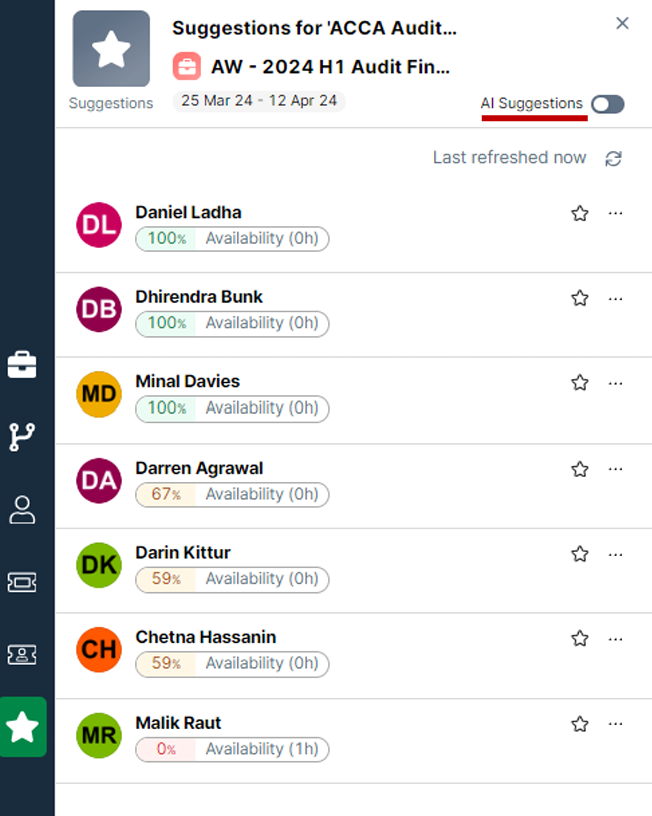
Capacity management
We've all been there, realising too late that a team is overloaded while another is twiddling their thumbs. Resource management software prevents these situations by constantly monitoring workloads. It flags potential issues before they become problems. Too many projects landing in Q3? The system will let you know before your team burns out.
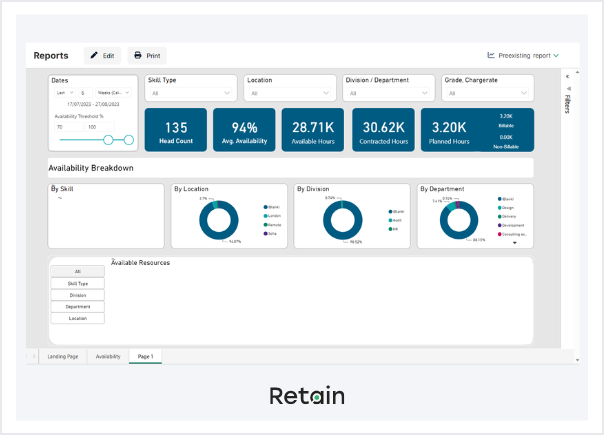
Integration with business systems
Nobody likes double-entry, and modern resource management systems know it. That's why it talks to your other business systems. It pulls holiday dates from HR, project deadlines from your project management tools, and budget info from your financial systems. Everything stays in sync without you having to chase updates across different platforms.
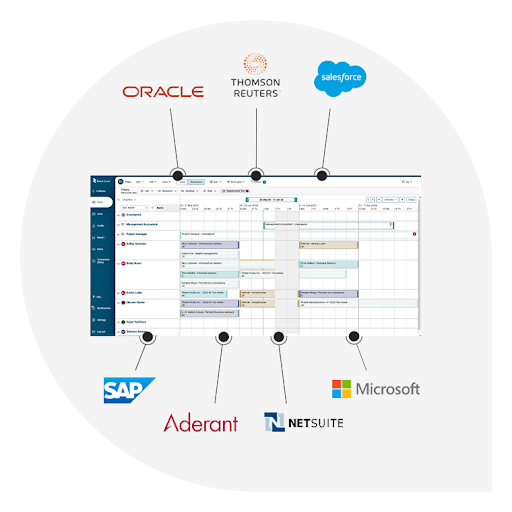
Why your business needs resource management software
If you're still relying on spreadsheets and manual scheduling, you're likely facing some familiar challenges. In fact, we have a dedicated ebook on this exact topic if you’d like to find out more.
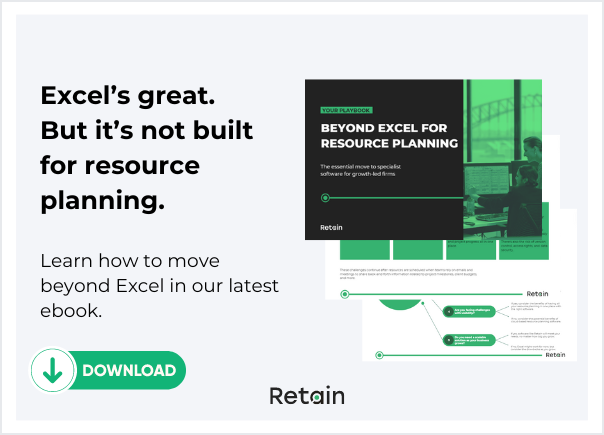
Let's look at the real impact of inefficient resource management, and more importantly, how the right software solves these issues.
Hidden costs of poor resource management:
1. Project delays and budget overruns: When you can't accurately forecast resource needs or spot potential shortages, projects inevitably suffer. Without proper visibility, projects frequently overrun their original timelines simply because the right people aren't available at the right time.
2. Skills gaps and mismatched assignments: Without proper skills tracking, you're working blind. That specialist knowledge you desperately need for a project? It might already exist in your organisation. You just can't see it.
3. Employee burnout and underutilisation: It's a common scenario: some team members are overwhelmed while others aren't working to their full potential. This imbalance leads to stress, decreased productivity and ultimately, talent loss.
4. Revenue leaks: When you can't track utilisation effectively, billable hours slip through the cracks. Even a 5% improvement in resource utilisation can translate to significant revenue gains.
Resource management software key features
Let's cut through the sales pitches and marketing jargon. What features actually matter when you're managing resources day to day? Here's what to look for in a resource management system that'll make your life easier.
#1. Smart scheduling and resource allocation
Gone are the days of manual scheduling headaches. Modern resource management systems use AI-powered scheduling that spots gaps, conflicts, and opportunities you might miss. Need to find a Java developer who speaks French and has financial sector experience? A good system will show you matching team members in seconds, not hours.
The real game-changer? These systems learn from your scheduling patterns. They'll start suggesting better matches based on past project success, not just skills on paper.
#2. Skills and capacity management
Your team's skills are your secret weapon—if you can track them properly. Today's resource management systems maintain detailed skills databases that go way beyond basic CV information. They track certifications, experience levels, and even soft skills for better team chemistry.
These systems also help with capacity planning, helping you spot potential skills gaps months before they become problems. Planning a major bank audit next quarter? Your system will tell you if you need to upskill existing staff or bring in new talent.
#3. Resource forecasting and analytics
Making decisions about resources isn't just about today—it's about next month, next quarter, and next year. Modern systems give you crystal-clear visibility into future resource needs. They'll show you exactly when you're likely to hit capacity issues or when you'll have bandwidth for new projects.
The best part? These forecasts are based on real resource planning data from your projects, taking into account everything from typical project overrun rates to seasonal variations in workload.
#4. Custom dashboards and reporting
Different stakeholders need different views of your resource data. Project managers want detailed availability information. Senior leaders need high-level utilisation metrics. Finance wants cost and billing data. A good resource management system lets you create customised dashboards for every audience.
Want to know your team's utilisation rate for Q2? Or how many iOS developers you'll need in six months? These reports are available in seconds, not after hours of spreadsheet wrestling.
#5. Seamless integrations
No software is an island. The best resource management systems play nicely with your existing tools—whether that's your project management software, HR system, or financial platforms. This means no double-entry of data and no information silos.
When someone books a holiday in your HR system, their availability automatically updates in your resource planner. When a project timeline shifts in your project management tool, resource allocations adjust accordingly. It's all connected, and it all just works.
5 benefits of resource management software
Let's talk numbers. When global accounting firm RSM Cayman implemented a modern resource management system, they slashed admin time by 16 hours per week. Rickard Luckin saved £17,000 annually just by reducing manual scheduling work. These aren't isolated cases—they're typical examples of what happens when you get resource management right.
Measurable financial benefits
The financial impact goes beyond saving admin costs. Without proper resource management, businesses typically lose revenue through poor utilisation. Modern systems help you reclaim this lost revenue through multiple channels. You'll maximise billable hours through better resource allocation, reduce project overruns by spotting resource conflicts early, and cut down on expensive contractor costs through better internal resource use. Perhaps most importantly, you'll identify underutilised talent that could be deployed on billable work.
Improved project delivery
Better resource management directly impacts your ability to deliver projects successfully. Global firms using these systems report consistently faster project completion rates and more accurate delivery timelines. They've dramatically reduced project delays due to resource bottlenecks and achieve higher quality deliverables through better skills matching. One Fruitman Kates resource manager notes that client delivery improved dramatically as new projects could start sooner due to enhanced demand management.
Enhanced team performance
It's not just about the numbers. It's about your people too. Modern resource management systems help prevent burnout by spotting overallocation early and improve job satisfaction through better skills matching. They support career development by tracking and utilising diverse skill sets, while enabling more flexible working patterns without sacrificing productivity. BPM LLP achieved rapid adoption across their practices specifically because the system made life easier for their teams, not harder.
Strategic business insights
Today's resource management systems provide valuable data for strategic decision-making. Leaders get clear visibility of capacity versus demand and early warning of skills gaps. They can make data-driven hiring decisions and create accurate forecasts for business planning. Gerald Edelman used these insights to build compelling business cases for new hires, backed by solid utilisation data.
The ROI is clear
The business case for proper resource management is clear. Companies consistently report a 30-35% reduction in manual processes and 5-10% improvement in utilisation rates. They see significant reductions in administrative overhead and better project profitability through improved resource allocation. The evidence is clear: effective resource management isn't just a nice-to-have—it's a crucial driver of business success.
Common resource management challenges (and how software solves them)
Every business faces resource management challenges, but some are more costly than others. Let's look at the most common issues organisations face and how resource management systems, like Retain, tackle them.
The visibility problem: Before implementing resource management software, many firms struggle with a common issue: they simply couldn't see what their consultants were working on. Resource managers spent hours emailing different departments trying to piece together who was available. Now, they can instantly see their entire resource pool, including skills, availability, and current assignments.
Cross-department communication breakdowns: Gerald Edelman found that having multiple teams involved in projects led to constant coordination headaches. Resource planning calls would take hours, with two or three people spending valuable time making basic decisions. Their new resource management system transformed these hours-long meetings into quick, data-driven decisions that take minutes.
The skills matching challenge: SpaceTec Partners faced a growing challenge: keeping track of resource availability while matching complex skill requirements. Their resource management system now maintains detailed records of team capabilities, making it simple to find the right person for each project. This means projects start faster and deliver better results because they're properly staffed from day one.
Managing growth and scale: RSM Cayman's story is particularly telling. As they expanded from 20 to over 50 personnel in just three years, their Excel-based system couldn't keep up. Multi-user access became impossible, and version control was a nightmare. Their resource management system solved these scaling issues, providing a single source of truth that grew with their business.
The utilisation balance: One of the trickiest challenges is maintaining optimal utilisation across teams. Fruitman Kates discovered they had both overworked and underutilised staff members, often simultaneously. Their resource management system highlighted these imbalances, allowing them to redistribute work more effectively and maintain healthier utilisation rates across all teams.
Future planning uncertainty: BPM LLP found that their rapid growth combined with multiple resourcing mechanisms created a planning nightmare. Without proper forecasting tools, they couldn't effectively plan for future projects or make informed hiring decisions. Their resource management system now gives them clear visibility into future resource needs, enabling proactive rather than reactive resource planning.
How to choose the right resource management system
When choosing a resource management system, it's ok to be picky. This will be your go-to tool for managing your organisation's talent. Once set up, it should do the heavy lifting for you so that you can focus on higher-level strategy.
Let's look at the most critical features you should consider.
Must-have features
Modern resource management systems should offer intelligent resource recommendations powered by AI, helping you match the right people to the right projects. You'll want robust planning and forecasting tools that give you clear visibility into future resource needs.
Look for systems that offer comprehensive skills management. This isn't just about tracking what certificates people have—it's about understanding the real capabilities of your workforce and matching them effectively to project requirements.
Time tracking and utilisation monitoring are also essential. As we saw with Rickard Luckin, the right system can save thousands in administrative costs while improving resource efficiency.
Beyond the features
But choosing the right system isn't just about ticking boxes on a feature list. Consider factors like:
✅Security and compliance requirements—particularly important for firms handling sensitive client data.
✅Ease of use—BPM LLP's success came partly from choosing a system their team actually enjoyed using.
✅Scalability—RSM Cayman's experience shows how crucial this is for growing organisations.
✅Integration capabilities—your system needs to work seamlessly with your existing tools.
Want a detailed guide to selecting the right resource management software? We've created a comprehensive breakdown of nine essential features to look for, along with practical evaluation criteria. Read the full article here.
Resource management software vs traditional methods
Many businesses still rely on spreadsheets and manual scheduling for resource management. But the world of work has changed. Let's explore why traditional methods no longer cut it in today's dynamic business environment.
Spreadsheets might seem like a cost-effective solution, but they're costing your business more than you think. Manual resource management typically consumes 15-20 hours per week in administrative tasks alone. That's time your skilled managers could spend on strategic work.
When manual processes start to crack, the signs are clear: Projects get delayed because resource conflicts weren't spotted early enough. Skilled team members sit idle while others are overworked. Decisions are based on outdated information. Client deadlines get missed because you couldn't see the capacity issues coming.
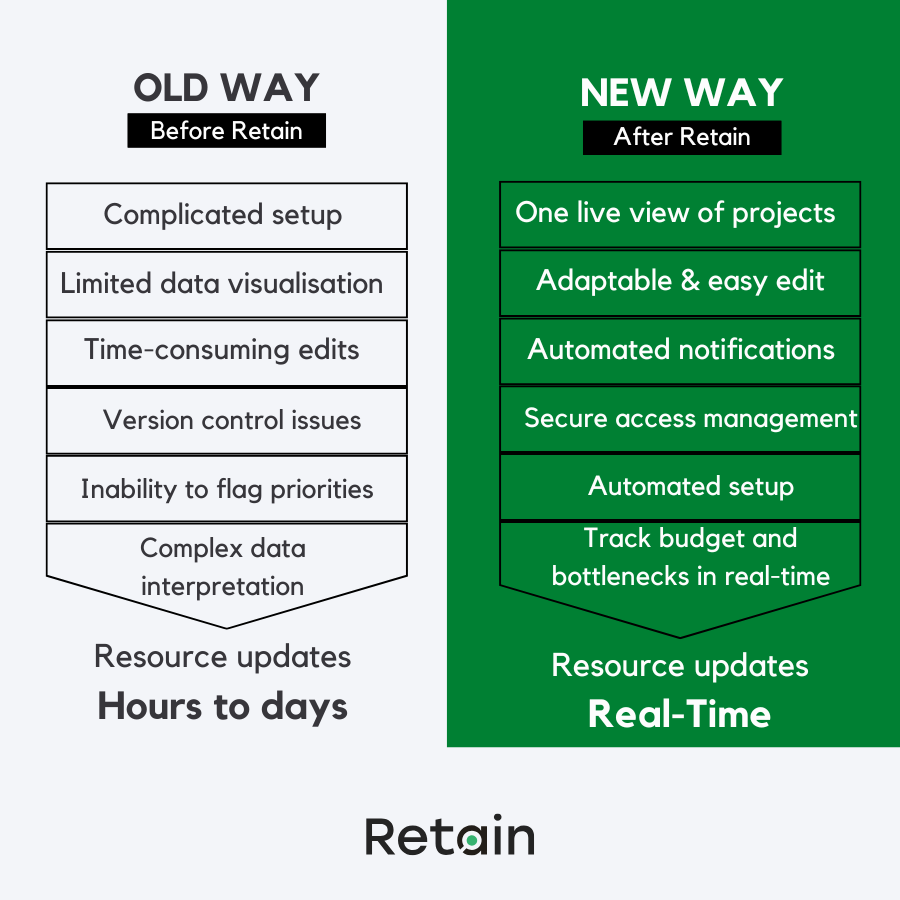
Beyond the obvious time waste, traditional methods have other significant drawbacks. Version control becomes a nightmare when multiple managers need to make changes. Important details get lost in email chains. And without real-time updates, you're always working with yesterday's information.
Modern resource management software takes these headaches away through intelligent automation. Instead of spending hours updating spreadsheets, managers can focus on strategic decisions. The system handles routine tasks like availability checks, skill matching, and conflict detection automatically.
Perhaps the biggest difference is in planning capability. Traditional methods leave you constantly reacting to problems. Modern systems help you spot potential issues weeks or months in advance. This means you can prevent resource bottlenecks before they impact your projects.
Moving from spreadsheets to modern resource management software might seem daunting. But with the right system, the switch can be surprisingly smooth. Most businesses see positive results within the first month, with significant improvements in resource utilisation and project delivery times.
The future of resource management is here
Resource management has evolved far beyond spreadsheets and manual scheduling. Modern businesses need systems that can handle the complexity of today's work environment; hybrid teams, multiple projects, and rapidly changing skill requirements.
The right resource management system transforms how your business operates. It frees your managers from admin burden, ensures your talented people are working on the right projects, and gives you the insights needed to make strategic decisions. Most importantly, it helps deliver what matters: successful projects, satisfied clients, and engaged employees.
The evidence is clear. Companies using modern resource management software report significant improvements across their business:
☑️Time savings of up to 16 hours per week in administrative tasks
☑️Improved project delivery rates and client satisfaction
☑️Better employee engagement through optimised workloads
☑️Clear visibility into resource capacity and future needs
☑️Enhanced ability to match skills with project requirements
Ready to transform your resource management?
See how modern resource management software can revolutionise your business operations. Book a demo today and discover how to unlock your team's full potential.
